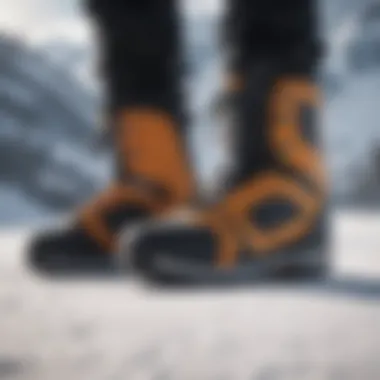A Comprehensive Guide to Snowboard Boots


Intro
Snowboarding, an extreme sport that combines elements of skiing and surfing, attracts enthusiasts seeking adventure on slopes covered in snow. The sport requires a unique set of skills, along with specific equipment, among which snowboard boots play a crucial role. Understanding the design, technology, and types of snowboard boots can significantly enhance both comfort and performance on the mountain.
Brief History of Snowboarding
Originating in the 1960s and 1970s, snowboarding began as an alternative to skiing, quickly gaining popularity. The first snowboard, called the "Snurfer," was invented by Sherman Poppen in 1965. As the sport evolved, so did the equipment, with the introduction of specialized boots in the 1980s, enhancing the riding experience.
Equipment Required
To start snowboarding, essential gear includes:
- A snowboard
- Bindings
- Snowboard boots
- Snow clothing (jackets, pants, gloves)
- Safety gear (helmet, goggles)
Among these, snowboard boots are vital because they connect the rider to the board. Properly fitted boots not only improve control but also ensure safety during rides.
Safety Tips and Guidelines
Safety is paramount in snowboarding. Here are some guidelines to consider:
- Always wear a helmet.
- Know your limits and ride within your skill level.
- Be aware of your surroundings on the slopes.
- Learn how to fall properly to reduce injury risk.
"The right snowboard boots can drastically improve your riding experience by offering better control and comfort."
Relevant Statistics and Facts
According to recent studies, snowboarding has seen an increase in participation over the past decades, with about 7.3 million people in the United States engaging in the sport annually. Moreover, snowboarding events have gained prominence in the Winter Olympics, showcasing the sport's global appeal.
Understanding the essentials of snowboard boots not only enhances safety but also contributes to a superior performance on the slopes. In the following sections, we will explore the various types of snowboard boots, factors for selection, and maintenance practices.
Prelude to Snowboard Boots
The right snowboard boots are very crucial for a successful snowboarding experience. Many enthusiasts focus too much on their boards or the style of their gear. However, the boots serve as the primary connection between the rider and the board. This section discusses why these boots deserve more attention.
Understanding the Importance of Snowboard Boots
Snowboard boots impact both comfort and performance on the slopes. A well-fitted boot absorbs the shocks from uneven terrains. Additionally, they keep your feet warm while allowing for better control during maneuvers. Choosing the right boot can prevent injuries. Poorly fitted or inadequate boots may lead to cold, tired feet, or even accidents due to lack of control.
Moreover, the type of riding you intend to do significantly influences your choice of boots. For example, a freestyle rider requires flexibility for tricks, while a freerider needs support for high-speed descents. Understanding personal preferences and styles is key.
"Your feet should be comfortable, secure, and supported to ensure the best experience riding down the mountain."
Overview of Key Components
Snowboard boots come with several vital components that enhance functionality and fit. Key elements include:
- Outer Shell: The shell provides protection against the elements. It also contributes to the overall stiffness of the boot.
- Liner: This is the interior part of the boot. Liners' materials often include foam or gel, providing cushioning and warmth.
- Closure System: This can vary from traditional laces to advanced systems like BOA. The design of the closure affects how snugly the boot fits.
- Footbed: This is the base layer that your foot rests on. A good footbed provides arch support, which can improve comfort and performance.
- Sole: A durable sole ensures traction, facilitating walking when off the board.
Choosing boots that include high-quality components is essential. Each part interacts with the rider's experience and overall control on the snowboard.
Types of Snowboard Boots
Understanding the types of snowboard boots is fundamental for anyone looking to enhance their snowboarding experience. This choice directly impacts performance, comfort, and overall satisfaction on the slopes. With various designs tailored to different riding styles and preferences, selecting the right type of boot can significantly affect handling and control during rides. The distinct features and purposes behind each type require careful consideration. Making an informed choice aids in better performance, ensuring you maximize your time on the snow.
Soft Boots vs Hard Boots
Soft boots are characterized by their flexible construction, which offers greater comfort and maneuverability. They feature a padded lining that conforms to the foot, allowing for an easy fit. This type is typically preferred by beginners and freestyle riders due to increased comfort during tricks and jumps. Soft boots allow for a wide range of motion, making it easier to navigate complex terrain.
In contrast, hard boots provide sturdier support and are generally used for alpine or racing styles. They have a rigid shell that offers better responsiveness and precision, essential for controlling high-speed descents. Experienced riders who engage in carving or racing often choose this option, as it delivers greater control and stiffness during turns.
Freestyle vs All-Mountain vs Freeride Boots
When choosing snowboard boots, one must consider their riding style. Freestyle boots are designed for riders who focus on performing tricks and jumps. They often have soft flex ratings, allowing for ease of movement and comfort during landings. These boots are lightweight and enhance the rider's agility on the terrain park.


All-mountain boots are versatile and suitable for various riding conditions. They feature a balanced flex, providing sufficient support for both freestyle and freeride contexts. This adaptability makes them a preferred option for riders who explore diverse terrains throughout their trips.
Freeride boots, on the other hand, are tailored for those who prefer backcountry and off-piste riding. These boots tend to have a stiffer flex to support aggressive riding. They offer enhanced stability and performance when traversing rough and challenging terrains. Each boot type is designed with unique benefits, thus allowing snowboarders to find their optimal pair based on their preferred riding style.
Specialized Boots for Wide Feet
Snowboarders with wider feet often face challenges in finding an appropriate fit. Specialized boots designed for wide feet are essential in addressing this issue. These boots have a broader toe box and often incorporate other structural adjustments to accommodate a wider foot. This design prevents discomfort and potential foot pain during longer rides.
Focusing on compatibility with specific foot shapes, these adjustable boots allow for a more natural fit. As a result, they enhance overall performance by ensuring that the rider has proper contact with the board. Selecting the correct size and fit becomes paramount when aiming for efficiency and comfort on the slopes.
"Finding the right snowboard boot is crucial for optimizing both performance and comfort, especially for those with unique foot shapes."
Selecting the Right Pair
Choosing the right snowboard boots is crucial for every rider. The right pair of boots can greatly enhance comfort, control, and overall riding experience. This section covers essential criteria for selecting your boots, focusing on several specific elements that contribute to optimal fit and performance.
Determining Your Riding Style
Understanding your riding style is the first step in selecting snowboard boots. Different riding styles demand unique features from boots. For instance, freestyle riders often prefer softer boots for flexibility and movement, while all-mountain riders might need a combination of support and responsiveness. Meanwhile, freeride enthusiasts typically look for stiffer boots that provide increased stability at high speeds.
Identifying your riding style helps narrow down your options. Choosing the correct type ultimately influences how effectively you can control your board. Analyze your preferences and consider where you most enjoy riding to better inform this decision.
Assessing Your Skill Level
An assessment of your skill level also plays a significant role in selecting snowboard boots. Newer snowboarders usually benefit from softer, more forgiving boots that allow for easier learning and increased comfort. As your skills advance, you may prefer stiffer boots that enhance control and precision.
Understanding your growth trajectory in snowboarding guides you toward the appropriate boot. This will not only help you ride better but also ensure you do not feel hindered by equipment that is too advanced for your current capabilities.
Foot Size and Boot Fit
Getting the accurate fit for your foot is paramount in boot selection. Poor fitting boots can lead to discomfort and improper control while riding. Here are some subtopics that explore this further:
Measuring Your Foot
Measuring your foot is the first step in understanding boot sizes. Use a measuring tape or ruler to determine your foot's length and width. This process should be done while standing, as your foot expands slightly under weight.
Knowing accurate measurements allows you to compare them against manufacturers’ sizing charts. This choice is beneficial, as improperly sized boots can cause blisters or restrict blood flow, leading to cold feet on the slopes.
Understanding Boot Sizing
Once your measurements are known, understanding boot sizing becomes essential. Different brands may have slight variations in their sizing. Therefore, referring to brand-specific sizing charts can prevent issues down the line.
A common characteristic of boot sizing is that it usually corresponds to your shoe size. However, it's important to note that not all boots fit the same way:\n * Some may run small, while others may be larger.
- Additionally, different styles of boots may have variations in size.
Understanding these nuances ensures a more tailored fit for your riding needs.
Testing the Fit
After you have chosen a size based on measurement and brand guidelines, testing the fit is critical. When trying on boots, ensure that they feel snug without being overly tight. Your toes should barely touch the end without curling.
It is a good idea to wear the socks you plan to use while riding when testing boots. Walk around in them, flex your knees, and mimic your riding stance. This method of fit testing directly relates to performance on the board. A well-fitted boot promotes better control and stability, which are crucial in challenging conditions.
"The right snowboard boot transforms your ride and enhances your overall performance on the slopes."
Technological Innovations in Snowboard Boots
Technological innovations in snowboard boots play a crucial role in enhancing performance and comfort on the slopes. As snowboarding evolves, so does the equipment designed to maximize the riding experience. It is essential to understand how advancements in boot design and technology can lead to improved stability, control, and overall enjoyment during rides.
Lacing Systems and Closure Mechanisms
Traditional Laces


Traditional laces are one of the most recognized methods for securing snowboard boots. This system provides riders with a reliable and customizable fit. The main characteristic of traditional laces is their simplicity and adjustability. Users can tighten or loosen the laces according to their preference. This method allows for various tightening styles, enabling a personalized fit for both comfort and performance.
However, traditional laces require periodic checks throughout the day to ensure they stay tight. While they are popular due to their straightforwardness, some riders may find them less convenient compared to newer technologies.
Speed Lacing Systems
Speed lacing systems bring a modern twist to the traditional method by allowing for quick adjustment. This system often utilizes a combination of cables and tighteners for easy pull-and-release functionality. The main benefit of speed laces is their convenience. Riders can tighten their boots in seconds without needing to stop on the trail.
Additionally, these systems often provide even pressure distribution, which enhances comfort. However, because of the mechanical components involved, speed lacing systems can sometimes be more prone to damage than traditional laces.
BOA Closure System
The BOA closure system offers one of the most innovative solutions in snowboard boot technology. This system uses a dial mechanism that allows for precise adjustments with minimal effort. The key characteristic of the BOA system is its durability and efficiency. Riders can easily customize the tightness of their boots in different zones, leading to improved responsiveness and support.
The unique feature of the BOA system is its quick release function. In emergency situations, loosening the boots is as easy as a press of a button. Despite these advantages, some users may find the initial cost higher than traditional lacing methods. The potential for malfunction in the dial mechanism may also concern some riders.
Heat Molding and Custom Liners
Heat molding and custom liners are significant advancements in personalizing snowboard boots. This process allows the foam interior of the boot to be molded to the rider's specific foot shape. By applying heat, the liners become soft and take on the contours of the foot, providing an exceptional fit.
This customization can drastically improve overall comfort and performance. Riders with unique foot shapes often experience fewer pressure points, which can lead to a more enjoyable time on the slopes. However, it's essential to ensure that the heat molding process is performed correctly, as improper heating can damage the boots or result in inadequate fitting.
Innovative Materials and Construction
Modern snowboard boots are constructed using advanced materials that enhance performance. The incorporation of lightweight synthetic materials not only reduces the overall weight of the boot but also improves insulation and breathability. Many manufacturers focus on creating water-resistant and durable finishes to withstand harsh winter conditions.
Also, innovations in construction techniques, such as seamless designs, result in fewer seams and therefore fewer pressure points. This enhancement leads to increased comfort and better energy transfer while riding. However, it is vital for riders to balance material choices with the need for sturdiness and resilience since performance can be affected by the choice of materials used in construction.
In summary, technological innovations in snowboard boots significantly contribute to the performance, fit, and enjoyment of snowboarding. Understanding each aspect helps riders make informed choices that align with their personal preferences and riding styles.
The Relationship Between Boots and Performance
Understanding the connection between snowboard boots and performance is crucial for every snowboarder. The right pair can truly enhance your riding experience, allowing for greater control, stability, and support. This relationship encompasses how these elements affect your overall performance in varied snow conditions and terrain.
Stability and Support
Stability is essential for effective snowboarding. A boot that provides solid ankle support ensures that your movements are translated correctly to the board. When you initiate turns or absorb landings, the stability of your boots helps maintain balance. A boot with poor support can lead to fatigue and lack of control, increasing the risk of injury.
Support comes from both the material and design of the boot. Softer boots offer mobility, suitable for freestyle riders, while stiffer boots provide support for aggressive riding styles.
Don't underestimate the impact of fit. A snug fit around the heel and ankle is vital for effective power transfer. Tight-fitting boots will keep your foot in place, enabling precise control over your board.
Flex Ratings Explained
Flex ratings refer to the stiffness of the boot. Each snowboard boot has a rating, usually on a scale from soft (1-3) to hard (9-10). Softer boots are more forgiving, providing greater flexibility for maneuvers and tricks. They are ideal for beginners or those who enjoy a laid-back riding style.
On the other hand, stiffer boots offer less flex, making them suitable for advanced riders who require more precision and support. This stiffness allows for better edge control and response when carving at high speeds.
Choosing the right flex rating depends on individual riding style and conditions. Riders tackling rugged terrain might benefit from a stiffer boot, while those focusing on park tricks may prefer softer designs.
How Fit Affects Control
The fit of your boots directly influences control. A poorly fitted boot can lead to slippage inside the shell, causing unnecessary movement during rides. This can significantly hinder your control over the board, making it difficult to execute turns or jumps.
A custom fit, often achieved through heat molding or the use of padded liners, enhances control and comfort. Ensure that your toes lightly brush the front of the boot when standing straight, but without feeling cramped.
Adjusting the lacing systems can also impact fit and control. A secure lace or BOA system ensures that boots maintain consistent pressure, translating to more confidence on the slopes.
"Whether you are hitting the slopes hard or taking a casual ride, the right boots can drastically affect your performance. Make informed choices for an optimized experience."
Boot Maintenance and Care
Maintaining your snowboard boots properly is crucial for both performance and longevity. Proper care ensures that your boots offer peak performance and remain comfortable throughout their lifespan. Neglecting maintenance can lead to issues such as decreased performance, uncomfortableness, or even injury while riding.


Regular maintenance of snowboard boots has several benefits:
- Prolongs Lifespan: Proper care can significantly extend the life of your boots, allowing for better long-term value.
- Enhances Performance: Clean boots perform better, providing better grip and responsiveness.
- Improves Comfort: Maintaining the interior of the boots prevents discomfort during rides.
- Minimizes Odors: Regular cleaning helps prevent the buildup of moisture and odors.
By understanding the specifics of boot maintenance, riders can ensure their equipment remains in optimal condition.
Cleaning Techniques
Keeping your boots clean is the first step in maintenance. Here are some effective cleaning techniques:
- Remove Snow and Ice: After a day on the mountain, remove any snow or ice buildup. Use a soft brush or cloth to wipe off the exterior.
- Wash the Liners: If the liners are removable, take them out and wash them separately. A mild soap solution can help remove dirt and odors. Always let them air dry completely before reinserting them into the boot.
- Use Specialized Products: Many companies offer cleaning solutions specifically designed for snowboard boots. These can effectively clean and protect materials without causing damage.
Remember: Never use excessive water or submerge your boots as this can damage the materials and adhesives used in the construction.
Storage Best Practices
Proper storage of your boots is essential, especially during the off-season. Here are some best practices for boot storage:
- Dry Completely: Before storing, ensure your boots are completely dry to prevent mold and mildew. Use newspaper or a boot dryer to absorb moisture.
- Store in a Cool, Dry Place: Avoid extreme temperatures and humidity when storing boots. A closet or a box with proper ventilation works well.
- Use Boot Trees: If available, using boot trees can help maintain shape and prevent lumping of the material.
Avoid storing your boots in areas where they can be exposed to sunlight or extreme heat.
Troubleshooting Common Issues
Riders may encounter several issues with snowboard boots over time. Here are some common concerns and their solutions:
- Unpleasant Odor: Odors can often be resolved with regular cleaning and drying of the liners. If persistent, consider using specialized odor-fighting products.
- Lacing Issues: If laces or closure systems become stuck or malfunction, ensure they are clean. Sometimes, a small amount of lubricant can help ease movement.
- Fit Problems: If the fit becomes loose over time, check if the liners have packed out. Purchasing new liners or using heat molding can improve fit.
By regularly performing maintenance, understanding cleaning methods, following proper storage practices, and identifying common issues, snowboarders can optimize their experience on the slopes.
Emerging Trends in Snowboard Boot Design
The evolving nature of snowboard boot design reflects advancements in technology and shifts in consumer preferences. Understanding these emerging trends is crucial for riders who want to optimize their performance and comfort on the slopes. Snowboard boots are not just accessories; they play a significant role in a snowboarder's overall experience. Innovations can enhance comfort, increase performance, and leverage sustainability—all of which are essential for today’s environmentally conscious athletes.
Sustainability in Material Choices
Sustainability has emerged as a pivotal concern for many industries, and the snowboard equipment sector is no exception. Brands are increasingly focusing on the environmental impact of their products. The sourcing of materials is under scrutiny. High-quality, sustainable materials like recycled plastics, organic cotton, and natural rubber are becoming popular choices.
Using sustainable materials in snowboard boots can reduce carbon footprints and promote a healthier planet. For extreme athletes, the performance qualities of these materials can also be appealing. Common benefits include increased durability and improved insulation, which can enhance comfort during long sessions in cold conditions.
It is essential for consumers to look for brands that prioritize sustainability. This might include certifications or clear messaging about the materials used. Moreover, reviewing the longevity of products can also reveal which brands are making serious commitments toward eco-friendly practices. The impact of personal choices can create a ripple effect in the industry, leading more companies to innovate with planet-friendly options.
Smart Technology Integration
The integration of smart technology into snowboard boots is revolutionizing how athletes approach their shredding. This trend manifests through features such as heated liners, which provide warmth and comfort, and sensors that measure performance metrics. These technologies can adjust to various conditions and feedback from riders, helping them fine-tune their riding experience.
Some boots now come equipped with Bluetooth connectivity, allowing riders to connect with mobile applications. This connectivity can be used to track performance statistics or customize boot settings from a smartphone. For instance, users can adjust the tightness of the boots or monitor their heat settings through an app.
The benefits of these innovations extend beyond comfort. Serious riders can leverage data collected to enhance their performance. Such information helps in developing better techniques and understanding the dynamics of their rides. Emerging technologies in snowboard boots hold the promise of not just evolving the sport but also enhancing every athlete's connection with their equipment.
"The future of snowboard boots is not just in design but in technology that enhances the ride experience for every athlete, making it more connected and comfortable."
Culmination
In this guide, we have explored the essential elements surrounding snowboard boots. The comprehensive review highlights the significance of selecting the right pair, considering factors such as boot types, fit, and the latest technological innovations.
Summarizing Key Points
To summarize, key points include:
- The Importance of Boot Fit: A proper fit enhances control and comfort, which directly influences performance on the snow.
- Variety of Boot Types: Understanding the different types, including soft and hard boots, is crucial for tailored riding experiences.
- Technological Advances: Innovations like heat-molding, advanced lacing systems, and smart technology are reshaping the landscape of snowboard boot design.
- Maintenance Practices: Regular care and proper storage extend the longevity and performance of your boots.
Overall, recognizing these elements will aid snowboarders in making informed choices, improving their riding experience.
Looking Ahead in the World of Snowboard Boots
The future of snowboard boots looks promising with ongoing advancements in sustainability and technology integration. As more manufacturers embrace eco-friendly materials, the environmental impact of snowboarding can be significantly reduced. Furthermore, the integration of smart tech allows for enhanced customization and performance tracking, ensuring that riders can connect their experience on the mountain with digital insights.
As the sport evolves, staying informed about these trends will be essential for enthusiasts and professionals alike. The developments in snowboard boots will continue to shape riding styles and improve overall performance on diverse terrains.



